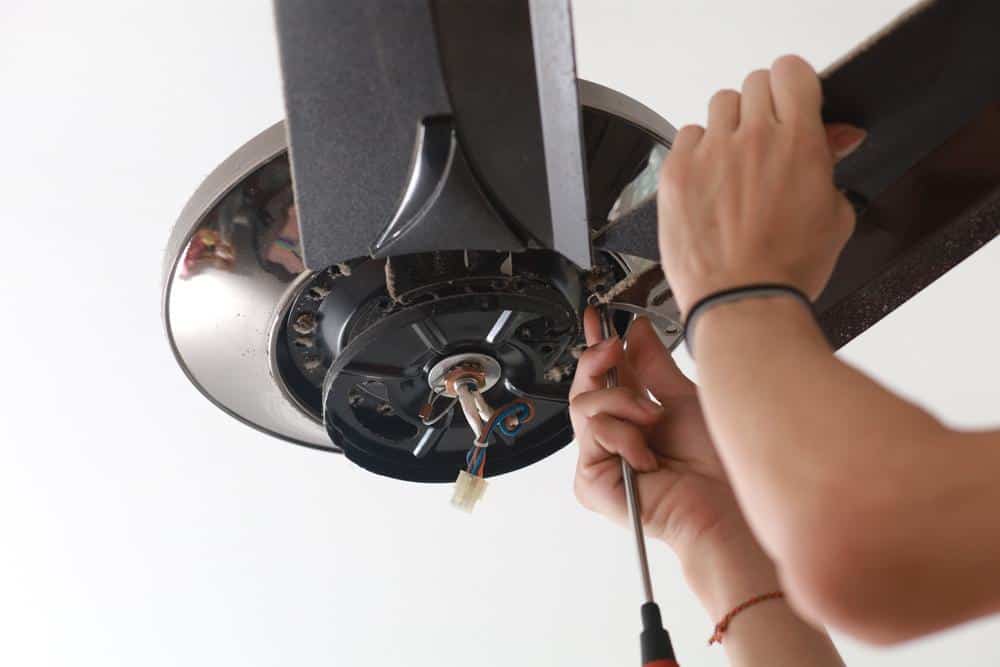
Ensuring the proper functioning of your ceiling fan is not only essential for maintaining a comfortable environment in your home but also for ensuring the safety of your household. One common issue with ceiling fans is loosening of the blades, which can lead to wobbling and inefficient operation. In this article, we’ll provide a comprehensive guide on how to tighten ceiling fan blades.
To tighten ceiling fan blades, first, turn off the power to the fan for safety. Then, inspect the mounting bracket and fan blades for any loose screws or signs of damage. Tighten any loose screws using a screwdriver or a battery-powered drill with a Philips tip bit. Also, ensure that the fan blades are clean, as dust and debris can cause imbalance and wobbling. Test the fan after tightening to check for any remaining wobbling. If the fan still wobbles, consider using a blade balancing kit or consulting a professional.
Signs That Indicate the Need to Tighten Ceiling Fan Blades
Before we delve into the process of tightening fan blades, it’s important to identify the signs that indicate the need for this maintenance. These include:
- Wobbling or shaking: A small wiggle up to 1/8-inch is normal, but any more than that could indicate loose screws or warped blades.
- Noises: A noisy, off-balance ceiling fan can lead to inefficient operation and excessive wear on the fan motor. Squeaks and whines can also be caused by loose or damaged blades.
- Warped or cracked blades: Inspect the fan blades for any signs of warping or cracking, as these can cause the fan to wobble and may indicate the need to tighten or replace the blades.
- Loose screws: Check and tighten all visible screws on your fan, including those holding the blades and any connections between the light and fan.
If you notice any of these signs, it’s essential to address the issue to prevent further damage to the fan motor and ensure safe operation.
Tools Required to Tighten Ceiling Fan Blades
Before starting the process, make sure you have the right tools on hand. These include:
- A battery-powered drill with a Philips tip bit.
- A screwdriver.
- A socket wrench, pliers, and thread locking compound (optional).
Step by Step Guide on How to Tighten Ceiling Fan Blades
Here’s a detailed step-by-step guide on how to tighten your ceiling fan blades:
- Turn off the power: Ensure the fan is switched off and cannot accidentally turn on while you work on it. For extra safety, you can also flip the circuit breaker to cut power to the room.
- Inspect the mounting bracket: Check the mounting bracket for any loose screws or hardware. Tighten any loose screws you find.
- Tighten the mounting screws: Examine the hanger ball and ensure it is firmly seated in its groove. Tighten the downrod support screws and replace the canopy cover if necessary.
- Check the fan blades: Inspect each fan blade for any signs of warping, damage, or loose screws. Tighten any loose screws on the blades.
- Clean the fan blades: Dust and debris can accumulate on the blades, causing imbalance and wobbling. Clean the blades thoroughly to remove any dirt.
- Test the fan: Turn the fan back on and check for any remaining wobbling. If the fan still wobbles, you may need to balance the blades using a blade balancing kit or by taping coins to the blades to find the right balance.
By following these steps, you should be able to tighten your ceiling fan blades and reduce any wobbling. If the issue persists, consider consulting a professional for further assistance.
Common Mistakes to Avoid When Tightening Ceiling Fan Blades
When tightening ceiling fan blades, there are several common mistakes to avoid:
- Not turning off the power: Before working on the fan, ensure that the power is off to avoid accidents.
- Not cleaning the fan blades: Dust, dirt, and debris can accumulate on the fan blades, causing them to become off-balance and wobble. Clean the blades thoroughly before tightening them.
- Not checking the fan’s mounting: Ensure that the fan is mounted correctly. An electrical box designed for light fixtures only cannot support the weight of a ceiling fan.
- Not inspecting the blades for damage: Look for blade cracks, warping, or other damage that could cause wobbling. Damaged blades should be replaced.
- Not ensuring that all blades are at the same height: Check that all fan blades are at the same height, as uneven blades can cause wobbling.
- Not using the right tools: Use a screwdriver or a battery-powered drill with a Philips tip bit to tighten the screws properly.
By avoiding these common mistakes, you can ensure that your ceiling fan blades are tightened correctly and safely, reducing the risk of wobbling and potential accidents.
Conclusion
Regular maintenance of your ceiling fan, including checking and tightening the blades, is essential for its efficient operation and longevity. By following the steps outlined in this guide, you can ensure that your fan operates smoothly and safely.
Frequently Asked Questions
How frequently should I check my ceiling fan blades for looseness or damage?
It’s a good practice to check your ceiling fan blades for looseness or damage every six months. However, if you notice any signs of wobbling, noise, or other indications of malfunction, check the fan immediately.
Do I need a professional to tighten the blades of my ceiling fan?
While it’s beneficial to have a professional check your ceiling fan, most people can tighten the blades themselves using the steps outlined in this guide. However, if you’re uncomfortable performing these tasks or if the problem persists after your attempts to fix it, it’s advisable to consult a professional.
What should I do if my ceiling fan blades are warped or cracked?
If your ceiling fan blades are warped or cracked, they should be replaced. Operating a fan with damaged blades can lead to inefficient operation and potential safety hazards. Replacement blades can often be purchased from the manufacturer or a home improvement store.
Can I use any type of screwdriver to tighten the screws on my ceiling fan blades?
It’s recommended to use a Philips screwdriver or a battery-powered drill with a Philips tip bit to tighten the screws on your ceiling fan blades. Using the wrong type of screwdriver can strip the screws, making them difficult to tighten or remove.
What is a blade balancing kit and where can I get one?
A blade balancing kit is a tool that helps you balance the blades of your ceiling fan to eliminate wobbling. It usually includes a clip and weights that you can attach to the blades to find the right balance. You can purchase a blade balancing kit from most home improvement stores or online.












